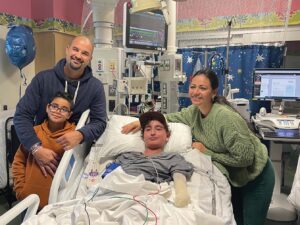Collaborative Care

Mathias Uribe, a previously healthy 15-year-old who enjoyed cross-country and playing the piano, was hospitalized for a very rare sequence of health issues in June 2023. What started as flu-like symptoms progressed to bacterial pneumonia with an invasive streptococcal infection and septic shock and resulted in a 143-day stay in the Pediatric Intensive Care Unit (PICU) at Monroe Carell Jr. Children’s Hospital at Vanderbilt.
Mathias spent two weeks on extracorporeal membrane oxygenation, which saved his life. Unfortunately, his hands and legs did not receive enough blood and required amputation.
The team worked meticulously, which involved many lengthy and complex operative procedures, to ensure Mathias was afforded optimal chances for prosthetics.
“Mathias developed necrosis of all four extremities that also involved the skin,” said Laxminarayan Bhandari, MD, assistant professor of Plastic Surgery at Monroe Carell. “It was important to us to try to salvage his joints and save as much tissue as possible to allow him the opportunity for the most function and better prosthetics options.”
To successfully salvage the joints, the team needed to use a procedure called a free flap that involves taking muscle from the patient’s back and attaching it to the knee by connecting the very small blood vessels of the muscle to even smaller blood vessels around the knee.
“We had extensive conversations with his family about the best way to move forward. While his surgeries were very challenging, we are so happy he has done so well.”
After his amputations, the team used some of the most innovative techniques to replace his skin, including biodegradable temporizing matrix, a synthetic material that helps regenerate new tissue for wound closure and reconstruction of complex wounds, and the RECELL System, an autologous cell-harvesting device that prepares, produces and delivers a regenerative cell suspension, Spray-On Skin Cells, using a small amount of a patient’s own skin. The Spray-On Skin Cells contain a combination of single living cells that stimulate healing and repigmentation throughout the wound bed.
“It was similar to a patient with fourth-degree burns,” said Elizabeth Slater, MD, associate professor of Plastic Surgery at Monroe Carell. “His injury from the effects of sepsis was one of the most severe I had seen.
“My goal was always independence for him, and his degree of injury threatened that. We are fortunate to have a multispecialty plastic surgery team.”
Slater complimented the PICU team, which was not accustomed to the complexity of wound care that was required for Mathias’ recovery.
Now that Mathias is in the rehabilitative segment of his recovery, Slater is looking forward to the day she sees her patient walk back into the hospital for a visit.
It’s a vision that his family embraced as they transferred Mathias to a rehabilitation facility in November 2023.
“He has faced adversity with unwavering courage, and we have no doubt that he will continue to do so throughout this journey,” said his father, Edgar Uribe. “We are in awe of his unwavering spirit and determination, which will undoubtedly guide him through the challenges that lie ahead.”
